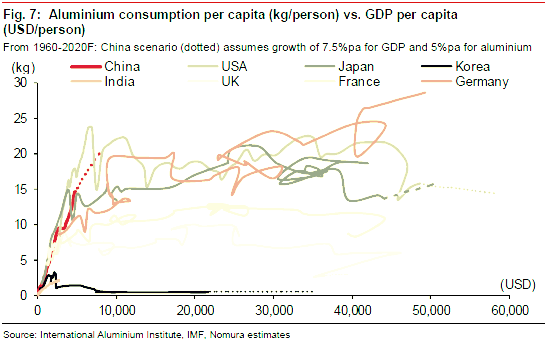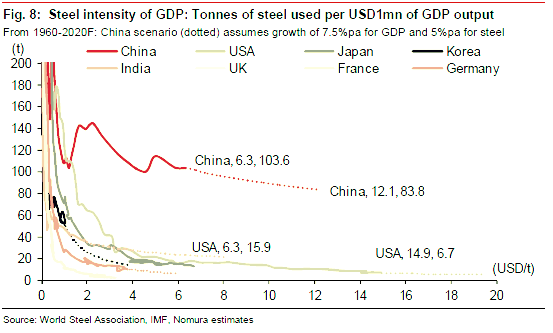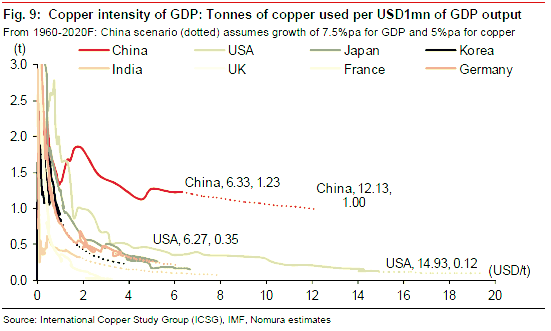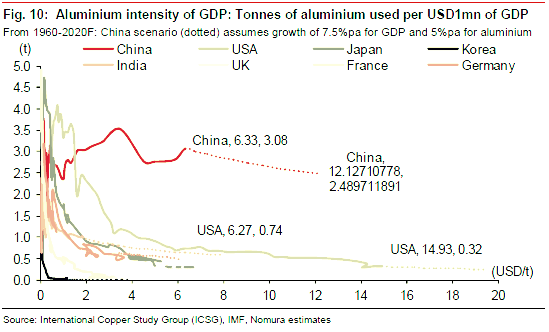Various investment banks have been weighing in on whether or not the end of the commodity/ steel/ metal and other super-cycles, which have been led primarily by China’s increasing demand. Credit Suisse has different teams on either side of the debate, and Citi thinks that it’s over. Now it is Nomura’s turn.
Similar to Citi’s argument, Nomura thinks that while commodity consumption per capita-type of analysis shows that China’s metal consumption does not look very stretched, this type of analysis is understating the true usage. Citi argues that the value in use (i.e. taking the prices of those metal into account) analysis shows that China has overtaken most of the developed world in terms of metal consumption, while Nomura points out that the amounts of various metals used per USD1 million of GDP for China are basically outliers and outrageously high:
Why we are different is more important than the fact we are different: Our analysis is focussed on metal intensity of China’s GDP, not per capita metal consumption
The point we wish to emphasize to readers is not so much that our forecasts are different, but why they are different.
We have performed a detailed analysis of metal intensity of GDP for steel, copper and aluminium in the following pages, which we believe clearly outlines our view that China’s economy is not large enough (in GDP terms) to support a continuation of the rapid growth in metal consumption seen in 2000-11.
Our conclusions are based on an analysis of China’s metal intensity of GDP rather than metal consumption per capita, and reflect a simple premise that while a country’s population size may be an important indicator of a country’s potential demand for industrial metals (per capita), the ability to meet potential demand is determined by the quantity of metal consumed in relation to the size of economic output (ie, GDP, not GDP per capita). Hence, in our view, metal intensity of GDP is a more important variable to monitor than per capita metal consumption.
The three charts below show the per capita consumption. As you can see, China is not really using ridiculous amount of various metals on a per capita basis:
On a consumption per GDP basis, however, China is outrageously high. In other words, for the same amount of GDP, China is already using much more steel, copper and aluminium than most other countries, as shown in the following three charts:
The reason is that, according to Nomura, the per-capita analysis ignores the composition of China’s GDP growth. China’s investment driven growth is very metals intensive:
We see metal-intensity charts as a proxy for fixedasset investment as a proportion of total GDP, with a higher metal intensity as a component of GDP signalling that a higher proportion of GDP is being generated from metal-intensive activities such as construction and fixed-asset investment. These charts plot tonnes of metal used to generate USD1mn of GDP (USD2010) on the left-hand side against annual GDP in USD trillion (USD2010) along the bottom, with the data from 1960-2011 as actual and with the dotted line as forecast for 2012-2020. A quick glance confirms that China’s GDP is significantly more metal intensive than those of the countries with which it is being compared, but more importantly China has created significantly more GDP at very high levels of metal intensity than other countries.
Thus China is using:
Significantly more steel to generate the same USD1mn of GDP as other countries
Significantly more copper to generate the same USD1mn of GDP
Significantly more aluminium to generate the same USD1mn of GDP
While they are not expecting a hard landing in the economy:
But a soft landing in China’s economy may initially feel like a hard landing in commodities markets until expectations adjust
Our view remains consistent with that of our economists and strategists, which is essentially there will be no hard landing for China as a whole, and through time China’s economy will begin to diversify away from construction-intensive to consumptionintensive activities. But it’s important for investors to recognize that a transition in China’s growth model will impact different sectors with different speed and severity.
Miners and mining-related companies have been among the largest beneficiaries of China’s rapid growth since 2001, and if China’s growth model is in the process of changing, even in a small way, then the negative consequences of such change are likely to be felt disproportionately by those who have benefitted the most from the previous trend, especially given current production expansion plans are designed to meet continued and rapid demand growth from China
The only bullish thing on metal stocks?
Gold equities are trading at 20-year lows on a forward PER basis: You don’t need to be a “gold bug” to buy gold equities here …





